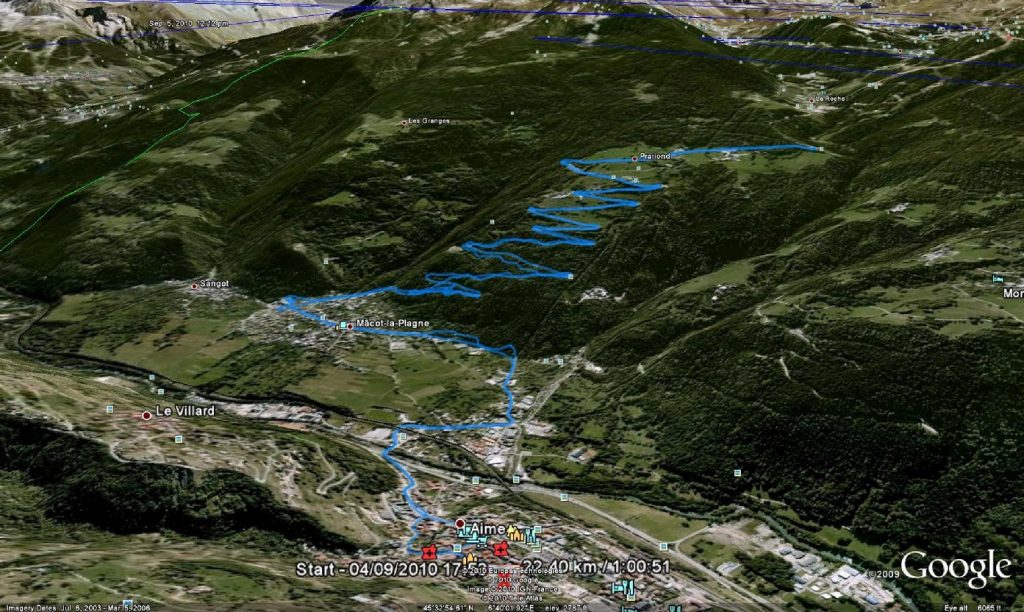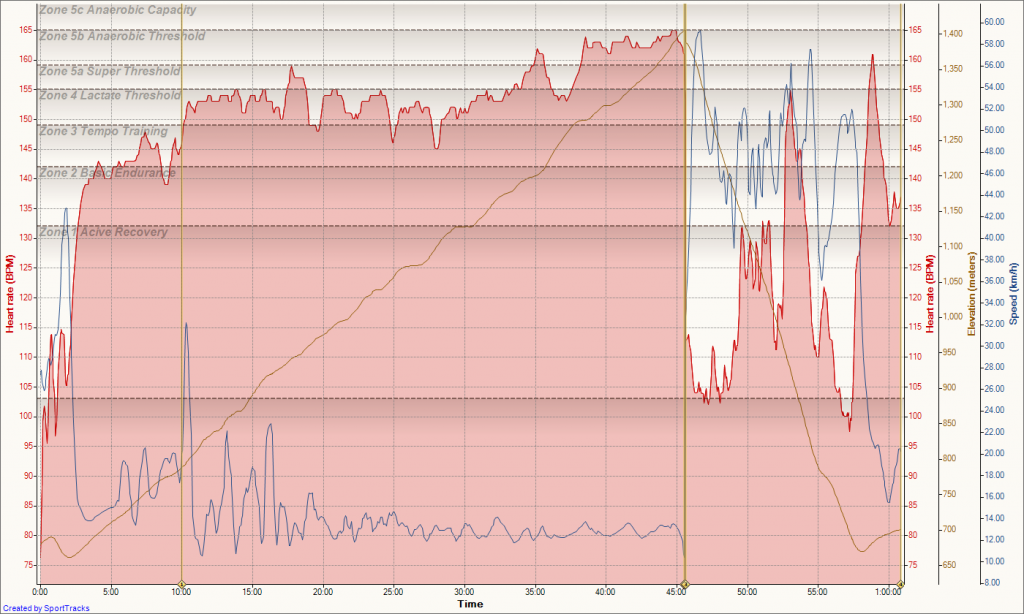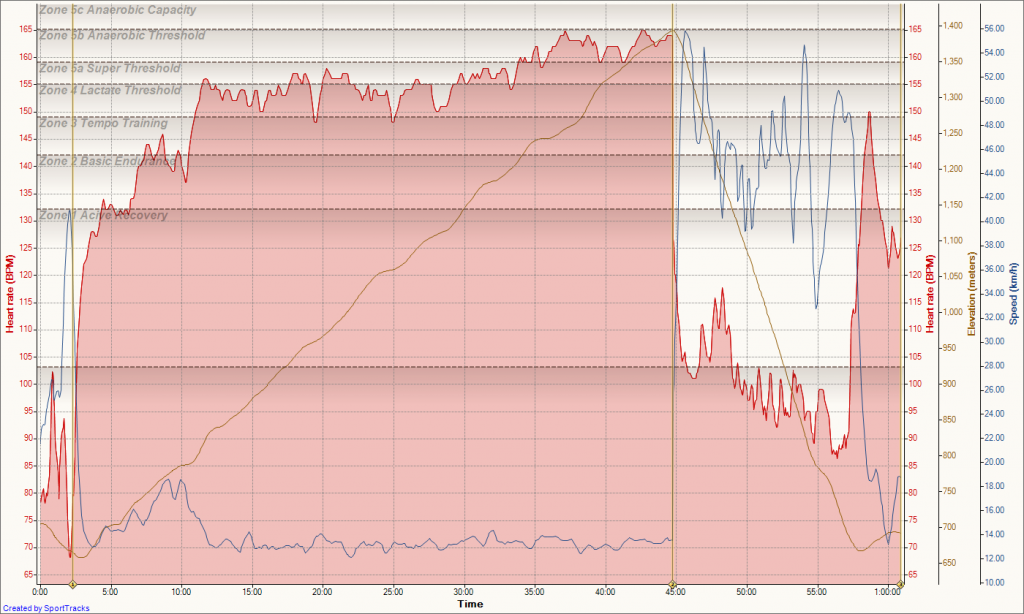Saturday 4th September 2010
Short high intensity workout today. Was a minute slower than personal best time – but not a surprise after only one full day of recovery since Colle St Carlos. What is interesting is that all the muscle pain from both during St Carlos and during the recovery was totally gone already and surprisingly did not return at all during this hard fast climb.
Getting more comfortable with the saddle height and the mechanics of pedalling differently. On the St Carlos there were moments when everything felt very “natural” both mechanically and bodily – but it was unconscious and not obvious why. Today the process became a bit clearer.
Learning
For me there is no mystery to “consciousness” despite the subject’s almost taboo status in psychology and its primary role in silly New Age religions. Consciousness is just a feedback system that permits us to re-program our behaviour – to learn and adapt – nothing more. I’ve read books written by PhD Physicists linking the bizarre qualities of quantum mechanics to Eastern religion etc. but they are all based on wishful thinking. The authors seem to think that their qualifications and education are a good substitute for intelligence and ironically their writings are clearly not guided by consciousness.
In the book “The Rider” by Tim Krabbé he describes how during sustained intense effort the brain must function smoothly like a well oiled ball bearing – with no resistance. That’s kind of what happens when you are done with the conscious learning and the whole thing slots into place unconsciously. There is more to it though. The “learning” is only assisted by the consciousness – it gets your actions into the ball park – but no further. Learning and performance in general stem from self-organisation. It’s an automatic optimisation of a system that we do not control – the same way a 3D stereogram takes shape in front of our eyes surprising us. You cannot consciously will the 3D image into view, but you can prepare the conditions so that it will happen to you.
With physical training you work on the patterns of movement making sure they correspond as closely as possible to advice from more experienced athletes. This guarantees that your movements will be somewhat mechanical and artificial as you search for improved feelings – but it does get you in the ball park. Feedback through video is even more powerful than a coach at this point. People may listen to a coach but somehow they often don’t register until they see it all on video. This “conscious” stage to training is really important if you need to change anything to develop – but it will never feel like a smooth well oiled ball bearing – neither in your brain nor in your body. It’s after a certain level of conscious work, repetition, practise and persistence that the magic happens. The self-organisation – the real learning – sneaks up on you from behind and takes you by surprise. This magic happens to you as a gift – but not from “god” or the universe – it’s from hard work. The Arabs say “Inshallah” – “God willing” – but the opposite is true. It’s when “God” is not willing that things get interesting and creative. Steven Hawking is currently in the news for publishing a book challenging Newton’s belief that gravity was due to “God”. Science has thankfully moved on a long way since Newton in 1650!!! Spontaneous self organisation is now an observed and better understood phenomenon. Hawking is right to say that with the existence of gravity that there is no need to invoke a god to explain spontaneous creation. The religious world responds smugly that Mr Hawking doesn’t understand. Unfortunately for them he does understand very well – but they don’t have a clue. Not only are they shockingly ignorant but they are being rapidly replaced by very large screen TV sets everywhere that they are not banned by the Taliban.
Spontaneous Creation
What happens next is that the body starts to connect all the dots. The dots that seemed random reveal a picture that could not have been guessed at – another level of organisation. In this case, the pedalling – the way all the components of the legs and bike are used suddenly come into focus. The forward/down stroke with one leg connects to the backward/upstroke with the other leg – through the body’s core – the lower abdomen. (All the positioning on the bike must be reasonably accurate to get this to happen). The upper abdomen, where the breathing muscles control the diaphragm, remain relaxed. The body settles into an effortless breathing rhythm, through the nose, using the diaphragm in shallow breathing. The physical output may be near maximum – anaerobic – but the whole system works together smoothly, body and brain like a well oiled ball bearing. It happens at first only when you are unconscious of the process – when you are focused on nothing that can distract or block the magic from working. That’s the effect of training and practise taking over from consciousness and then letting the body take it all up to the next unexpected level. When breathing has settled into a natural rhythm there is a natural pause between breathes – where the breathing muscles are totally relaxed and inactive – resting – even at maximum physical output.
This isn’t about cycling or endurance sport. The same thing happens in any physical activity – playing a musical instrument or skiing – just the same. It’s why learning is interesting- and why anyone who isn’t learning is dead.
One Last Thing
How do you know when something is “right”? Many years of teaching skiing and playing a fiddle (difficult!) have made this one clear to me. Something is right when eventually, instead of trying hard to do it, it starts happening to you – yes, “self organisation” again. In fact its only then that you really “understand” it. (whatever “understand” means). The other thing that indicates something to be basically “right” is that it then acts as a building block for the next levels – it opens doors.
Technical
Advantages of Reduced Breathing (“Siberian System of Self Suffocation” – as some Russian wag tagged it)
One surprising advantage is that increased CO2 levels in the blood reduce the perception of pain. Coffee tends to increase respiration but it also has a similar effect on pain. I don’t find coffee having too big a detrimental effect on my breathing (7 breathes per minute at rest) – so perhaps I am getting the advantage of both of them together.
Currently finding that rapidly increased physical efforts are hard to deal with in Reduced Breathing. The body needs a period of several minutes to adapt – for the breathing centre to get used to higher CO2 levels. This is most likely an accurate way to measure “warm up”. Like many people I’m a bit too impatient to take 40 minutes to warm up so I often jump straight into the workout. It’s during the first 20 minutes or so, when effort is rapidly increased, that you feel suffocated by nasal breathing. The solution I use is to back off a bit on the effort – not much – but enough to get reasonably comfortable. People who are in bad shape or health can react negatively to rapid increases in CO2 levels. It’s clear that lung and blood CO2 levels rise rapidly with any sharp increase in physical output. The question is whether or not an improvement in breathing adaptation/health would deal with it – or whether the real issue is not having warmed up. My current “Control Pause (CP)” – that is – a completely comfortable pause in breathing after an exhalation from a normal breath – is 43 seconds – which is good, but short of the 60 seconds recommended for optimum health. Some people can get this up to 180 seconds. This “CP” is not just a test it is part of training for reduced breathing. I wasn’t even aware of a natural pause in my own breathing between breathes until I started studying this. The length of time the Control Pause lasts is determined by how well your body is oxygenated – which is linked strongly to the level of CO2 in your body. Low CO2 levels though over-breathing means low Oxygen levels.
When an amateur diver wants to free swim underwater he will hyperventilate – over breathe – prior to diving. Professional divers will never do this because they know it can kill them – it’s that powerful. The over breathing empties the CO2 out of the lungs and then the body can’t extract oxygen out of the blood and the swimmer falls unconscious and drowns.
The trick with the most effective pedalling seems to be in coordinating both legs to work together through the centre – core/abdomen – instead of dealing with each pedal stroke as a separate event. Saddle height seems to play a critical role in this and even a few millimeters in height can throw it off – reducing the actions to disconnected components.
Analysis Weight 67.5kg, Max hr 185bpm, Min hr 38bpm, Body fat 12.1%
Still a bit tired from previous outing – but very similar cardiac levels despite falling 1 minute behind last week’s effort -bellow…



